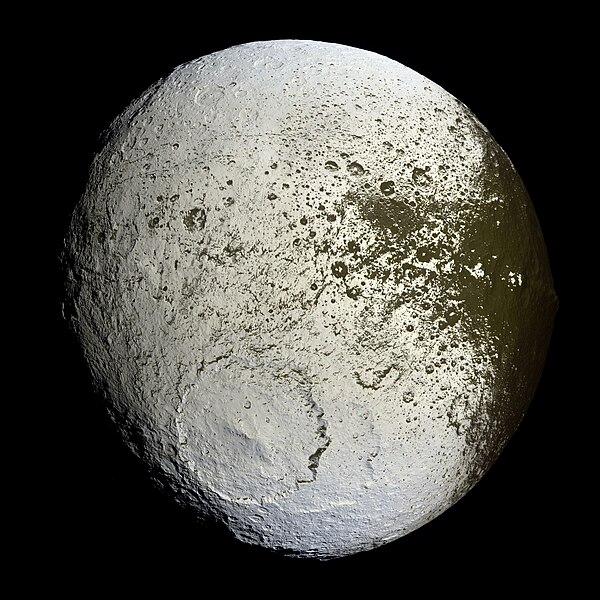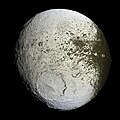Fitxategi:Iapetus as seen by the Cassini probe - 20071008.jpg

Aurreikuspen honen neurria: 600 × 600 pixel. Bestelako bereizmenak: 240 × 240 pixel | 480 × 480 pixel | 768 × 768 pixel | 1.024 × 1.024 pixel | 2.048 × 2.048 pixel | 4.032 × 4.032 pixel.
Bereizmen handikoa ((4.032 × 4.032 pixel, fitxategiaren tamaina: 6,22 MB, MIME mota: image/jpeg))
Fitxategiaren historia
Data/orduan klik egin fitxategiak orduan zuen itxura ikusteko.
| Data/Ordua | Iruditxoa | Neurriak | Erabiltzailea | Iruzkina | |
|---|---|---|---|---|---|
| oraingoa | 20:07, 12 abendua 2018 |  | 4.032 × 4.032 (6,22 MB) | Kesäperuna | 100% JPEG quality from full quality TIFF, slightly cropped to be more centered. |
| 11:18, 9 urria 2007 |  | 4.100 × 4.100 (1,56 MB) | Startaq | {{Information |Description = Cassini captures the first high-resolution glimpse of the bright trailing hemisphere of Saturn's moon Iapetus. This false-color mosaic shows the entire hemisphere of Iapetus (1,468 kilometers, or 912 miles across) visible fro |
Irudira dakarten loturak
Hurrengo orrialdeek dute fitxategi honetarako lotura:
Fitxategiaren erabilera orokorra
Hurrengo beste wikiek fitxategi hau darabilte:
- af.wikipedia.org proiektuan duen erabilera
- an.wikipedia.org proiektuan duen erabilera
- ar.wikipedia.org proiektuan duen erabilera
- ary.wikipedia.org proiektuan duen erabilera
- arz.wikipedia.org proiektuan duen erabilera
- ast.wikipedia.org proiektuan duen erabilera
- az.wikipedia.org proiektuan duen erabilera
- ba.wikipedia.org proiektuan duen erabilera
- be.wikipedia.org proiektuan duen erabilera
- bg.wikipedia.org proiektuan duen erabilera
- bn.wikipedia.org proiektuan duen erabilera
- bn.wikibooks.org proiektuan duen erabilera
- bs.wikipedia.org proiektuan duen erabilera
- ca.wikipedia.org proiektuan duen erabilera
- ckb.wikipedia.org proiektuan duen erabilera
- cs.wikipedia.org proiektuan duen erabilera
- cv.wikipedia.org proiektuan duen erabilera
- cy.wikipedia.org proiektuan duen erabilera
- de.wikipedia.org proiektuan duen erabilera
Ikus fitxategi honen erabilpen global gehiago.




